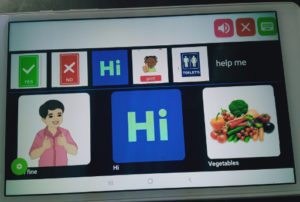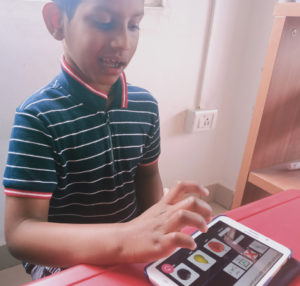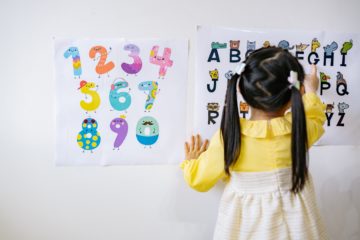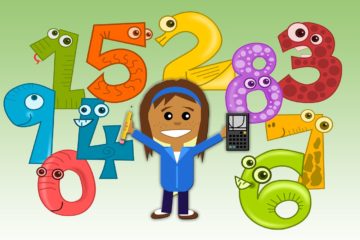Today’s blog is all about AAC!! Read on to find out about different types of AAC, PlayTalk and how to use AAC for better communication…
What is AAC?
 We all use different forms of AAC everyday like facial expressions, gestures, writing notes and passing it to a person etc. We may not realize how often we communicate without talking. Augmentative and Alternative communication refers to the various methods of communication that can help people who are unable to use verbal speech, to communicate.
We all use different forms of AAC everyday like facial expressions, gestures, writing notes and passing it to a person etc. We may not realize how often we communicate without talking. Augmentative and Alternative communication refers to the various methods of communication that can help people who are unable to use verbal speech, to communicate.
What are the types of AAC?
There are broadly two types of AAC: unaided and aided. Unaided systems rely on the user’s body like gestures, pointing, facial expressions, sign language etc. Aided systems rely on external equipments like communication books, alphabet board, Speech Generating Devices (SGD).SGDs are gaining more popularity owing to the ease of use, portability and advanced digital options that make it easier for a person with disability to communicate. At PlayStreet, we make sure every child gets the opportunity to communicate, not just verbally but through AAC also. Two aided AACs that we use at PlayStreet are PlayTalk and Avaz, both requiring a tablet or digital notepad to be installed. Avaz is an Indian app that can be downloaded and is supported in IOS devices. PlayTalk AAC is an app developed in-house by the founders of PLayStreet, Mrs.Mini Dwivedi Gopinathan and Mrs. Shereen Idiculla and is designed to be used on Android devices.
Why AAC for communication?
Master B (6 years) had a communication difficulty which made him unable to make sounds or produce words clearly. Stating his needs/ideas across to others was always a stressing experience for him as his message would not be understood by others. The message would have to be repeated several times and despite all his efforts, they may still not be understood by the caregiver. This was a frustrating experience for the child and when he was not being understood by others around him, he eventually started to throw up tantrums/other behaviours to release this frustration. When the team trained him to use an AAC device, his messages were easily understood and thereby reduced his frustration and anger levels. His problem behaviours reduced and he could communicate with more precision using his AAC device. Master B is currently studying in a mainstream school (with assistance of a shadow teacher) and he enjoys using his device to communicate with his peers and teachers!
For children who are on the Autism Spectrum, initiation of communication is often a problem. They may not indicate their needs spontaneously to the caregiver. Picture based AAC apps provide a solution to this, as pictures are more easier to understand than abstract words. The App thereby helps the child to initiate communication for basic daily needs. PlayTalk is one such app which was devised to help children with communication difficulties initiate their communication independently. The PlayTalk app is a service to help with communication, language development and education with the complete understanding of the child, parents’, speech therapists and educators’ perspective.
How does PlayTalk help? 
PlayTalk app comes with a structured program that helps a child to progress from one word communication to communicating in sentences. PlayTalk has 5 levels with Level 1 helping the child to start initiating a communication exchange independently and levels 3, 4 and 5 involving more complex sentences. PlayTalk has multiple options to add images from the web or click pictures in natural setting using the device. Level 1 of PlayTalk itself focuses on single picture communication, expanding spontaneity and generalization of communication, picture discrimination, page navigation and basic matching. After level 1 has been mastered, child will move to level 2 and so on. Communication does not mean identification of pictures! To get a better understanding of various communicative functions that can be achieved using PlayTalk, please refer the table below:
|
Functions |
Description |
Example |
| Introduction to social scripts | Introducing greetings in daily communication | ‘hello’, ‘bye’ |
| Requesting | Introducing the concept of requesting for their needs | ‘I want’ + juice |
| Labeling | Introducing nouns to label items | ‘car’, ‘tree’ (naming objects) |
| Rejecting | Introducing words to indicate things child does not want | ‘No’, ‘I don’t want’, |
| Express emotional/physical state | Introducing feelings/emotions to convey to others while experiencing the emotion | ‘happy’, ‘angry’, ‘tired’ |
| Spontaneous Commenting | Introducing concepts like adjectives, size, colour etc to comment on events | ‘I see big car’ |
| Answering questions | Introducing the comprehension of simple and complex questions | ‘what’, ‘when’, ‘where’ questions etc |
| Narratives | Introducing narration of events or stories through sentences | Story narration/personal event (watch video link) |
| Ask questions | Introducing the concept of asking simple and complex questions | ‘Where is your house?’ |
| Express manners | Introducing social manners in daily communication | ‘Thank you’ |
| Call someone | Introducing the concept of call to people to express their needs | ‘mom’ |
| Assert independence | Conveying that they can function independently | ‘I can do it by myself’ |
| Direct others actions | Directing others while carrying out an action | ‘Be careful’ |
| Share personal experience/ play | Indicating previous experiences/pretend play in group | ‘ Yesterday I went to mall’ ( watch video link ) |
| Share thoughts and ideas | Indicating own ideas to a person/group | ‘ I have an idea. Let’s all bake a cake. |
| Share factual information | Introducing to express quality or characteristic of being true or grounded in reality | ‘Two plus two equals four’ |
The PlayTalk app can be downloaded from the website https://www.playtalk.org
What should we really know about AAC??
The following points need to be kept in mind when using any AAC system:
- Ensure the child’s AAC system is portable i.e. can be taken with them wherever they go so that they never miss an opportunity to communicate, be it school, home, shopping or even a family function!
- If using an app on android or IOS, ensure it has sufficient battery charge.
- The use of AAC does not hinder language development but in fact facilitates it.
- AAC is not the ‘last resort’ when child fails to speak. Even with a child who can speak, AAC can be introduced as it promotes further language development.
- There is no particular age to start training the child using an AAC system. Even a toddler can be trained to start using an AAC device to foster better and independent communication!
- By using AAC, children learn to become independent in communication
So, let’s encourage more independent communication. Try it out with your kids and watch how excited they will be to use their own customized AAC device/board!



0 Comments